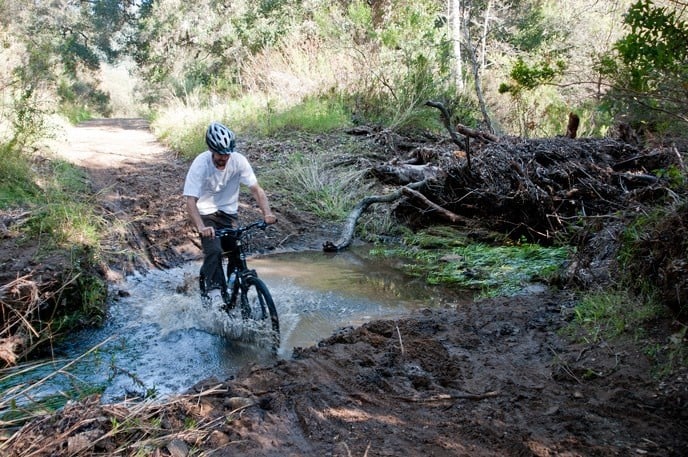Electric Motor Assist Mountain Bikes: Part 2 – e-Bike Implications for Land Managers
- Posted on
- By Geoffrey D. Smith
- Posted in electric pedal assist, eMTB, MTB
- 0

Evolving electric motor assisted mountain bike technology has profound implications for our public lands resources. Are you ready?
Wilderness and Bicycles
Electric Assist Mountain Bikes: Part 2 – e-Bike Implications for Land Managers
-- by Geoffrey D. Smith
In Part 1 of this 2-part series (April 2019), I offered an e-mountain bike (eMTB) primer. I talked about e-bike technologies, and got people thinking about the implications. If you’ve ventured out onto public land since then, perhaps you are now better able to recognize and understand the bicycles you are seeing out there.
Mountain bikes and other machines are not allowed in Wilderness under existing federal law. The conversation about mountain bicycles on non-Wilderness land is relevant to the extent that many of these lands are potential Wilderness, or adjacent to Wilderness, so there is a natural ‘spillover’ concern.
Recent developments in electric bicycle propulsion technology have brought these machines to a new level. They are now truly ‘motorized vehicles’, just without the gas and oil. So what does this mean for the integrity of our public lands resources? Answer: It means that as guardians of our public lands natural resources, we need to be informed and proactive in our advocacy for effective regulation of these machines. We need to step up our support of the agency land managers -- those on-the-ground stewards who see first-hand the impacts that recreational activities have on the resources. To be clear, organized mountain bike organizations have been advocating in this way for increased bicycle access for decades.
Bicycle Impacts on Public Lands
The impacts of mountain bikes on our public lands and wildlife resources have been debated for decades. We can continue to debate until the proverbial ‘cows come home’, but the reality is that the known and documented impacts of mountain bikes -- soil erosion, proliferation of trails, impacts to wildlife -- are amplified by the addition of electric motors. eMTBs travel faster, further, more quietly, and with greater impact to the soils and fauna than so-called ‘acoustic’ (non-motorized MTBs). Add to that the fact that yet more eMTB riders will be traveling on two wheels (not to mention three-wheeled recumbent trikes) into sensitive lands. As if that were not enough, we are now seeing a proliferation of so-called ‘gravel bikes’ and ‘cyclo-cross bikes’, which are ‘road’ bikes with fatter tires but no shock absorbers. Throw some bags on them, and now you have ‘bike packing’, the newest craze in off-road extended travel recreation.
Land Manager Implications
A good resource for assessing the land manager implications for eMTBs, admittedly from a pro-bicycle perspective, is the national People for Bikes organization. This nonprofit organization is a strong advocate for bicycles as transportation and recreation, both on-road and off-road. In my conversations with them both as a rider and a bicycle shop owner myself, I have been clear about my own concerns concerning expansion of the ‘multi-use’ approach to public lands trails design. Bicycle infrastructure on paved surfaces is surely deserving of improvements in design and capital investment. However, when the conversation turns to public lands off-pavement recreation, the conversation must be very different since land management mandates are clearly unique, and focused on resource protection.
What you can do
I urge the reader to review this People for Bikes on-line resource at ttps://peopleforbikes.org/our-work/e-bikes/for-land-managers/. There you will find a trove of information about how public lands are being managed throughout the US. In many cases, land management policies are only just now being updated to reflect the growth of MTB and eMTB use in these ares. You need to be at the table for these discussions.
Finally, know that personal relationships are very important. Connect with your local land managers, whether they be city, county, state, or federal. Get to know them personally. Work with these dedicated land manager staff to help organize colleagues to work on service projects focused on restoration, interpretation and yes even ‘volunteer trail’ eradication. The managers -- recreation staff, biologists, district rangers, information officers -- need to know that non-mountain bike riders are organized, too!
Geoffrey Smith has been actively involved in federal wilderness advocacy for over 25 years, having organized around the first California Desert Protection Act (1994) and the California Wild Heritage Campaign. He now lives in Santa Rosa where he has settled into owning and operating a bicycle shop specializing in folding bikes… including non-motorized folding mountain bikes.
(Photo: Mountain bike rider crossing a stream in the Santa Monica Mountains, retrieved from https://www.nps.gov/samo/planyourvisit/bicycle.htm)
(Reproduced from 'Words of the Wild', August 2019. Sierra Club California)

Comments
Be the first to comment...